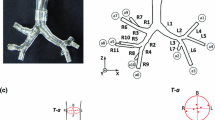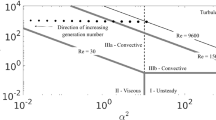Abstract
The objective of the study is an analysis of lung ventilation during breathing under rest conditions and for high frequency ventilation (HFV). The measurements include investigations of the flow using an endotracheal tube. A transparent model of the upper human lung airways down to the 6th generation was generated, and the oscillatory flow through the branching network was studied by DPIV. The method of refractive index matching of the fluid (water/glycerin) and the model (silicone) allows an unobstructed view into the internal flow network. The mass flow rate and the frequency were adapted to the characteristic flow parameters, the Reynolds- and the Womersley-number. The comparison of the results for normal breathing and HFV shows that a mass exchange occurs for higher frequencies known as Pendelluft, which could not be seen during normal breathing. This mass exchange between the daughter tubes is a consequence of the asymmetric impedance in the successive daughter branches. The lung topology determines the local pressure loss in the model and therefore the local mass flow direction of the Pendelluft. At higher frequencies we observed an increase in exchange between the daughter branches. The transformation of the velocity profiles between inspiration and expiration suggests a net mass flow which is created into the model along the centerline and the inner walls of the bifurcations. This flow is compensated with a net mass outflow to the trachea along the outer walls of the branches.





















Similar content being viewed by others
References
Brücker CH, Riethmuller ML (1998) Cyclic flow oscillations in a system of repeatedly branching channels. Phys Fluids 10(4):877–885
Brücker CH, Schröder W (2003) Flow visualization in a model of the bronchial tree in the human lung airways via 3-D PIV. In: Proceedings of PSFVIP-4, Chamonix, France, 3–5 June 2003
Dring RP (1982) Sizing criteria for laser anemometry particles. J Fluid Eng 104:15–17
Eckmann DM, Grotberg JB (1988) Oscillatory flow and mass transport in a curved tube. J Fluid Mech 188:509–527
Fredberg JJ, Keefe DH, Glass GM, Castile RG, Frantz ID (1984) Alveolar pressure nonhomogeneity during small amplitude high-frequency oscillation. J Appl Physiol 57(3):788–800
Haselton FR, Scherer PW (1982) Flow visualization of steady streaming in oscillatory flow through a bifurcating tube. J Fluid Mech 123:315–333
Horsfield K, Dart G, Olsen DE, Filley GF, Cumming G (1971) Models of the human bronchial tree. J Appl Physiol 31(2):207–217
Kitaoka H, Takaki R, Suki B (1999) A three-dimensional model of the human airway tree. J Appl Physiol 87(6):2207–2217
Lee WJ, Kawahashi M, Hirahara H (2006) Experimental analysis of pendelluft flow generated by HFOV in a human airway model. Physiol Meas 27:661–674
Marraro G (1992) Simultaneous independent lung ventilation in pediatric patients. Crit Care Clin 8:131–145
Melling A (1997) Tracer particles and seeding for particle image velocimetry. Meas Sci Tech 8(12):1404–1416
Mochizuki S (2003) Convective mass transport during ventilation in a model of branched airways. In: Proceedings of PSFVIP-4, Chamonix, France, 3–5 June 2003
Nowak N, Kakade PP, Annapragada AV (2003) Computational fluid dynamics simulation of airflow and aerosol deposition in human lungs. Ann Biomed Eng 31:374–390
Pedley TJ (1977) Pulmonary fluid dynamics. Ann Rev Fluid Mech 9:229–274
Perchet D, Fetita CI, Vial L, Preteux F, Caillibotte G, Sbırlea-Apiou G, Thiriet M (2004) Virtual investigation of pulmonary airways in volumetric computed tomography. Comput Animat Virtual Worlds 15(3–4):361–376
Ramuzat A (2003) Private communication. Von Karman Institut, Rhode Saint Genèse, Belgium
Ramuzat A, Riethmuller ML (2002) PIV investigations of oscillating flows within a 3D Multiple Bifurcation model. In: 11th international symposium on application of laser techniques to fluid flows, Lisbon, Portugal, paper 19-1, 13–16 June 2002
Rettwitz-Volk W, Schlosser R (1993) One-sided high-frequency oscillating ventilation in the treatment of neonatal unilateral pulmonary emphysema. Acta Paediatr 82(2):190–192
Tremblay LN, Slutsky AS (1998) Ventilator-induced injury: from barotrauma to biotrauma. Proc Assoc Am Physicians 110:482–488
Uchida S (1956) The pulsating viscous flow superposed on the steady laminar motion of incompressible fluid in a circular pipe. ZAMP 7:403–422
Ultman JS, Shaw RG, Fabiano DC, Cooke KA (1988) Pendelluft and mixing in a single bifurcation lung model during high-frequency oscillation. J Appl Physiol 65(1):146–155
Weibel ER (1963) Morphometry of the human lung. Springer, Berlin
Zhang Z, Kleinstreuer C (2002) Transient airflow structures and particle transport in a sequentially branching lung airway model. Phys Fluids 14(2):862–880
Zhang Z, Kleinstreuer C (2003) Species heat and mass transfer in a human upper airway model. Int J Heat Mass Transfer 46:4755–4768
Acknowledgments
The authors gratefully acknowledge the support of this project by the Deutsche Forschungsgemeinschaft, grant # BR 1494/7-1.
Author information
Authors and Affiliations
Corresponding author
Rights and permissions
About this article
Cite this article
Adler, K., Brücker, C. Dynamic flow in a realistic model of the upper human lung airways. Exp Fluids 43, 411–423 (2007). https://doi.org/10.1007/s00348-007-0296-0
Received:
Revised:
Accepted:
Published:
Issue Date:
DOI: https://doi.org/10.1007/s00348-007-0296-0




